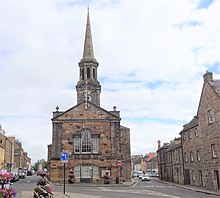Haddington Town House
| Haddington Town House | |
|---|---|
 Haddington Town House | |
| Location | Court Street, Haddington |
| Coordinates | 55°57′20″N 2°46′43″W / 55.9556°N 2.7787°WCoordinates: 55°57′20″N 2°46′43″W / 55.9556°N 2.7787°W |
| Built | 1745 |
| Architect | William Adam |
| Architectural style(s) | Scottish baronial style |
Listed Building – Category A | |
| Official name | Town Hall |
| Designated | 5 February 1971 |
| Reference no. | LB34185 |
 Shown in East Lothian | |
Haddington Town House is a municipal structure in Court Street, Haddington, East Lothian, Scotland. The structure, which is the meeting place of East Lothian Council, is a Category A listed building.[1]
History[]
The first municipal building in the town was a medieval tolbooth which dated back to the early 15th century.[2] It incorporated a drawbridge, a gaol for petty criminals and a spire.[2] The bell in the tollbooth was rung at 7am and 10pm every day from the mid-16th century.[3] By the 1730s, the building was in a dilapidated condition and meetings were transferred to the local library while the burgh leaders procured a new building.[2]
Construction of the new building started in 1742.[4] It was designed by William Adam in the Scottish baronial style, built in ashlar stone and was completed in 1745.[5] The design involved a symmetrical main frontage facing west along Court Street; it was initially arcaded on the ground floor so that markets could be held, with an assembly room on the first floor.[2] At the west end there were pilasters on the first floor supporting a pediment: after the markets had been abandoned, the ground floor was enclosed, a three-light segmental window was installed on the ground floor and, in 1788, a Venetian window was added on the first floor.[1] At the east end, there was a clock tower with a belfry to which a spire, designed by James Gillespie Graham, was added in the 1831.[5][6] Internally, the principal rooms were the cells for prisoners on the ground floor and the accommodation for the sheriff's court and the burgh council on the first floor.[2]
After significant population growth, the town was advanced to the status of small burgh, with the town house as its meeting place, in 1930.[7] Following significant deterioration in the structure of the building, which led civic leaders to consider demolition as an option, the building was extensively refurbished to a design by Peter Whitson in the mid-1950s.[4] Queen Elizabeth II, accompanied by the Duke of Edinburgh, visited the town hall to inspect the progress before undertaking a tour of the town on 7 July 1956.[8][9] The building was officially re-opened by Princess Mary later in the year.[4] It continued to serve as the headquarters of the burgh council for much of the 20th century,[10] and remained the meeting place of the enlarged East Lothian Council and its subcommittees after it was formed in 1975.[11][12][13]
Works of art in the town house include a painting by the locally-born artist, William George Gillies, of a Midlothian landscape,[14] a painting by William Darling McKay, who was born in Gifford, of cattle being driven on the salt marshes,[15] and a painting by Patrick Adam, who was born in Edinburgh, of Gullane Links.[16] There is also a painting by William Stewart MacGeorge, who was born in Castle Douglas, of a river with trees and a farm.[17]
See also[]
- List of Category A listed buildings in East Lothian
- List of listed buildings in Haddington, East Lothian
References[]
- ^ a b Historic Environment Scotland. "Town Hall (LB34185)". Retrieved 9 July 2021.
- ^ a b c d e Historic Environment Scotland. "Haddington, Court Street, Town House (56578)". Canmore. Retrieved 9 July 2021.
- ^ Winn, Christopher (2009). I never knew that about the Scottish. Ebury Press. ISBN 978-0091910242.
- ^ a b c "Haddington Town House set to be free of scaffolding again at last". East Lothian Courier. 25 July 2014. Retrieved 9 July 2021.
- ^ a b "Haddington Town House". Dictionary of Scottish Architects. Retrieved 9 July 2021.
- ^ Groome, Francis (1885). "Haddington". The Ordnance Gazetteer of Scotland. Retrieved 9 July 2021.
- ^ "Haddington Burgh". Vision of Britain. Retrieved 9 July 2021.
- ^ "Royal Visits to Addington". John Gray Centre. 1 June 2012. Retrieved 9 July 2021.
- ^ Gillon, Jack (2015). Haddington Through Time. Amberley Publishing. ISBN 978-1445643847.
- ^ "No. 17883". The Edinburgh Gazette. 16 December 1960. p. 751.
- ^ "Local Government (Scotland) Act 1973". Legislation.gov.uk. Retrieved 9 July 2021.
- ^ "£600,000 of work set to be carried out on Haddington Town House". East Lothian Courier. 15 June 2021. Retrieved 9 July 2021.
- ^ "Council Meeting Agenda". East Lothian Council. 29 October 2019. Retrieved 9 July 2021.
- ^ Gillies, William George. "Midlothian Landscape". Art UK. Retrieved 9 July 2021.
- ^ McKay, Willian Darling. "Driving Cattle on the Salt Marshes". Art UK. Retrieved 9 July 2021.
- ^ Adam, Patrick William. "Gullane Links". Art UK. Retrieved 9 July 2021.
- ^ MacGeorge, William Stewart. "River with Trees and a Farm". Art UK. Retrieved 9 July 2021.
- Government buildings completed in 1745
- City chambers and town halls in Scotland
- Haddington, East Lothian
- Category A listed buildings in East Lothian
